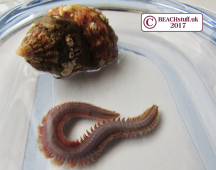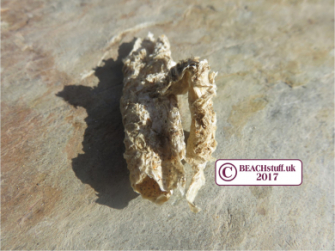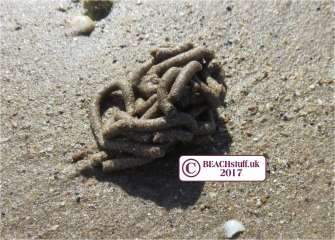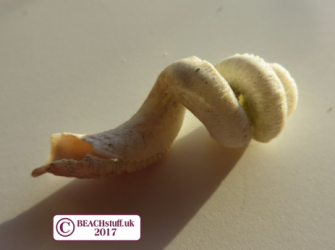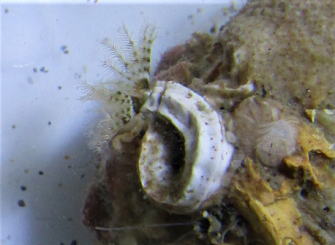

Marine Worms
We tend to think of those pink (often dead) worms in our garden when we think of worms, but they're on the beach too - and looking very different.
Don't sue me if you don't actually see a worm though - what you are more like to see is signs that a worm is around, rather than the actual worm itself.
Sea Mouse
or Aphrodita
The sea mouse is a type of polychaete worm (segmented, bristly worms) known as a scaleworm that can grow up to 30 centimetres long but are more usually around 10 or 15 centimetres in length. They feed on small crabs and hermit crabs and other worms. To warn off predators, they are covered in bristles which can flash green, blue or red.
They are common all round the coast of Britain but not found very often.
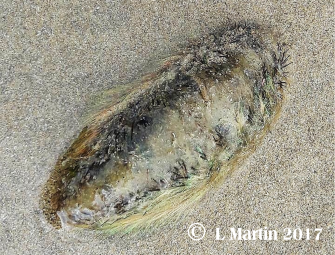
Lynn Martin found the sea mouse pictured in Westward Ho!.
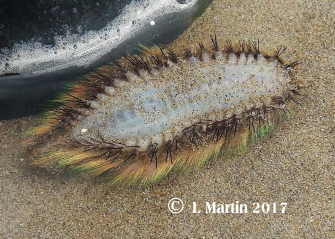
Ragworm
Ragworms are more commonly found in rockpools than when beachcombing but as this one turned up in a whelk shell I picked up on the strandline, I thought it deserved a place here. Another form of polychaete worm (see sea mouse above), ragworms like to hide in shells, under stones, and in silty sand, They forage for whatever they can find to eat - plant or animal, they are not fussy. Called ragworms as they go completely limp if picked up.
For more on rag worms, wriggle over to this page
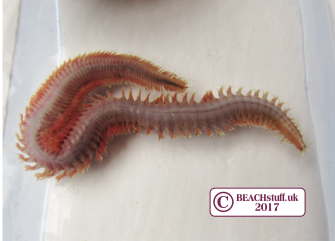
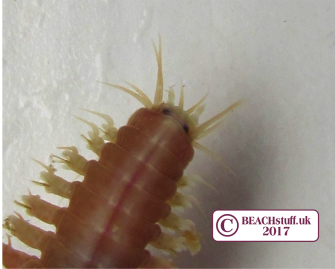
Paddleworm
Roughly in appearance, the paddleworm looks like a longer, thinner version of a ragworm.
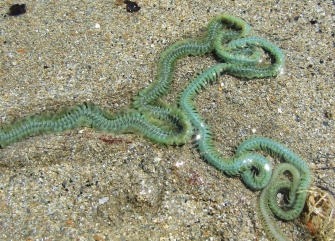
Lugworm
As lugworms go under the sand, they take in, and expel from their rear ends, little coiled mounds of sand known as worm poo.


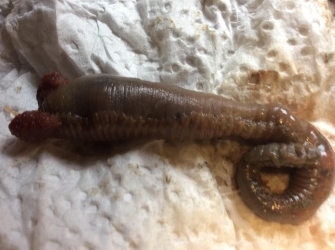
Sand Mason Worm
These worms build tubes rising out of the sand made from grains of sand and bits of shells,
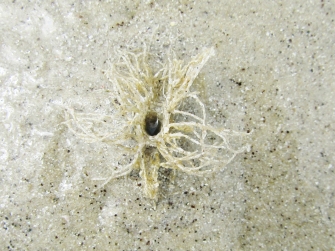

Parchment tube worms
These paper tubes - maybe a centimetre or more in diameter - are made by the parchment tube worm and afixed to the sea bed for the worm to live in. The worm itself looks actually more like a water-born centipede than a worm with a whole load of wriggling 'legs' along its body. The worm eats plankton floating in sea water - a filter feeder.

Keel worms
Tubes on a stone or shell (or on just about anything else that is in the sea) are made by tiny worms. The worm lives in the tube and then, when it wants to feed, it pushes out its 'tentacles' (below right) with which it traps plankton from the sea water.
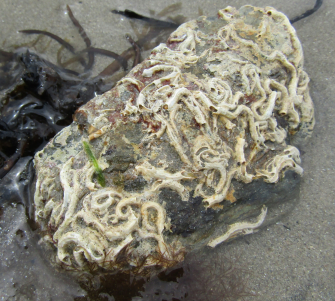
The species bove is likely to be Pomatoceros triqueter. This has less pronounced ridges than the other very common species pictured below - Pomatoceros lamarcki. This species has three pronounced ridges along the length of the tube.

Below - Pomatoceros triqueter
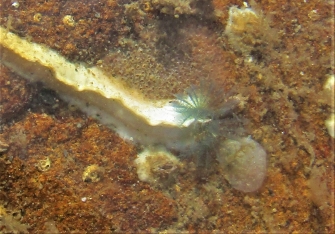
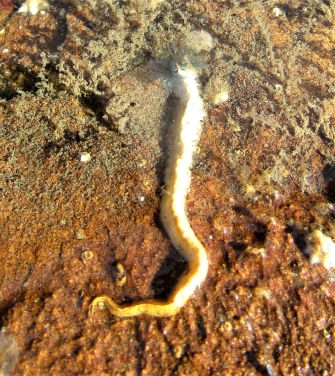
Below is pictured Serpula Vermicularis, a worm which creates tubes which are pinkish-white and without the three pronounced ridges of Pomatoceris Lamarcki.
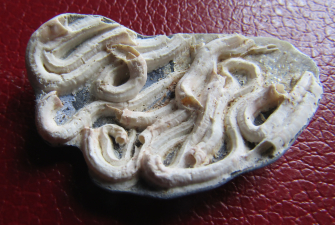
Female keelworms produce pink calcerous tubes (below).
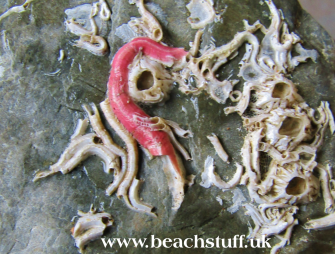
The very rounded tubes of the example above suggest that it may be hydroides norvegica.
The worm above is llikely to be
Pomatoceros triqeter
Spirorbis
Spirorbis spirorbis
Like the keel worms, the spirorbis worm makes itself a calcareous tube to live in (generally white or discoloured to cream or brown). These are tinier than the worms above - perhaps only three or four millimetres across - but the basic format of the worm is similar: it lives in the tube and puts out tentacles to feed. The spirorbis spirals are almost exclusively found on wrack seaweeds.
The key ID feature of spirorbis is that it is dextrally spiral ie. from the outside in, the curl is anti-clockwise.
Janua pagenstechri
Another annelid worm which creates very similar small spirals to spirorbis above. However, the tubes are smaller, only around 1 - 2 mm in diameter.
The key ID feature of this speacies (unlike spirorbis above) is that it is sinistrally spiral ie. from the outside in, the curl is clockwise.

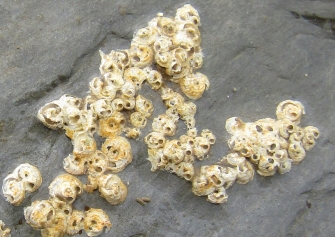
Neoamphitrite figulus
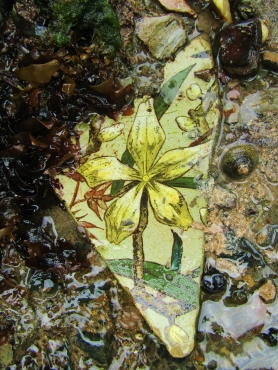
This pink worm was found underneath the beautiful tile above. I was going to make off with the tile but when I realised it was someone's home I decided to leave it where it was.
This is a pretty common worm which is often found living under stones on the shore of the UK.


Lugworm
Looking like a deposit of sandy poo, this is a sign of the lug worm. Of all the worms on this page, this is the one that looks most like our earth worm although you would have to dig fast and deep into the sand to see one. As they dig down, the sand they remove is piled up in the surface. They can grow to about nine inches (23 centimetres long).
Bloodworms
These are polychaete worms (like the lugworm above) in the Glycera genus. They live typically on the floor of shallow water.
In the photo below, you can just make out the black jaws of the worm.
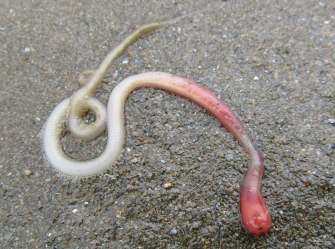

Incidentally, July 1st 2015 was the first ever International Polychaete Day. I haven't been able to find out whether there was ever a second ever International Polychaete Day...
Green Leaf Worm
Green leaf worms are usually found in rock pools rather than stranded on beaches. We have a whole page on them here.

Honeycomb worms
These tubes are the homes of the honeycomb worm - a very sociable worm which likes to live together with many other honeycombe worms giving us mounds of tubes. Each tube is made of sand grains and pieces of shell stuck together. The wotm itself pops its head out of the tubes to feed when the tide comes in.
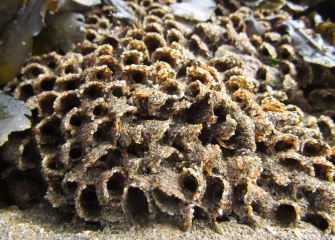
Bootlace worm
Lineus longissimus
This photo was taken by Robert Ward.
Bootlace worms are a type of ribbon worm and form the longest aninals in the world, being found 55 metres long! They are pretty common on UK coasts.
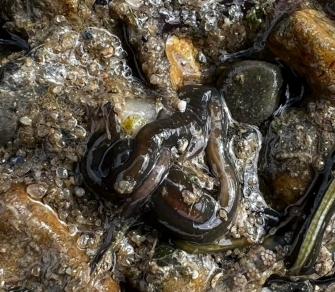
Medusa Worm
- also known as a spaghetti worm.
A polychaete worm - the 'spaghetti' is the tentacles of the worm, its long worm body being buried under the surface.
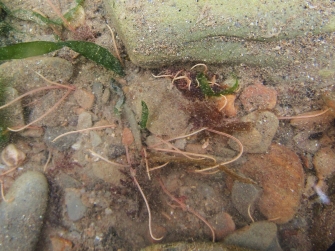
Ship worm
These holes, in a piece of wood that has long been at sea, are likely to have come from shipworms. These are not worms at all but a type of marine mollusc (or sea snail).

Not a worm...
Yes, this does look very similar to the calcareous worm tubes above but no, it is not the same thing at all. it's actually a snail. Have a look at this page if you don't believe me.
.
